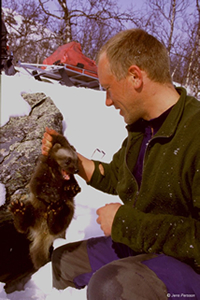
Dr. Jens Persson, Swedish Wolverine Project
The wolverine is the largest terrestrial member of the family Mustelidae. Its appearance is somewhat bear-like, although movement and associated behavior are distinctly characteristic of the weasel. The wolverine is powerfully built, with structural morphology apparently adapted for winter survival. The skull of the wolverine is robust; powerful dentition and associated musculature enable the wolverine to forage on frozen meat and bone. The trenchant skeletal characteristic of the family Mustelidae is reflected in the upper molars being rotated 90° inward. The dental formula of the wolverine is incisor 3/3, canine 1/1, premolar 4/4, molar 1/2 for a total of 38 teeth.
The wolverine’s head is broad and rounded with small dark eyes, a dark brown rostrum, brownish-black rhinarium, and short ears rounded obtusely. Its legs are of moderate length, with five toes on each foot. The posture of the front feet is plantigrade. However, the calcanea and metatarsals of the hind feet do not typically contact the ground during locomotion, or in the standing-resting position, resulting in some overlap between the plantigrade and digitigrade postural divisions. Some authors have assigned the foot posture to semiplantigrade (Thomas 1952, Banfield 1974), although additional considerations of osteological characters and hind foot flex points suggests that the wolverine is plantigrade (Ginsburg 1961, Carrano 1996), which along with its large feet facilitates travel through deep snow. Claws are curved, and while biomechanics of the toes may suggest the claws are semi-retractile, anatomically they are clearly fixed. Although not considered to display acute arboreal behavior, the wolverine can proficiently climb trees. They are not aquatic in nature, but are excellent swimmers. Males are typically 30-40% larger than females with males generally weighing 11 to 18 kg and females 6 to 12 kg (Banci 1994).
The wolverine’s pelage consists of underhair and guardhair, and in winter is generally a thick, glossy dark brown. Overall pelage coloration can have extreme variation from very dark brown to pale blonde (Holbrow 1976). A light, silvery buff or blonde facial mask is distinct in some individuals. A pale buff or blonde stripe originates at the nape of the neck or shoulders, runs laterally along the animal’s sides and merges at the terminus of the dorsum just above the base of a medium length bushy tail. The “lateral stripes” can range from extremely prominent to almost indiscernible. Wolverines typically have a pattern of light colored pelage on their throat and chest that is unique among individuals (Magoun et al. in press), while white hair on the digits, feet and forelegs is not uncommon. Wolverines experience vernal and autumnal molts.
Wolverines communicate through vocalizations and scent marking. A variety of vocalizations are used in the presence of conspecifics and kits. Chemical communication is accomplished via scentmarking with urine and abdominal rubbing. Although wolverines have well developed anal musk glands, musking appears to be used primarily as a fear-defense mechanism and is associated with cautionary raised tail posture (Long 1987). Contact with humans will usually elicit a vocal as well as chemical response. Although it appears that wolverines are primarily dependant on their acute sense of olfaction, there is no evidence that their vision or hearing capabilities are diminished.
<< Back to Species Account Overview
Literature Cited
Banci, V.A. 1994. Wolverine. Pages 99-127 in L.F. Ruggiero, K.B. Aubry, S.W. Buskirk, L.J. Lyon, and W.J. Zielinski, eds. The scientific basis for conserving forest carnivores, American marten, fisher, lynx and wolverine in the western United States. USDA Forest Service Rocky Mountain Forest and Range Experiment Station General Technical Report RM-254, Fort Collins, Colorado.
Banfield, A.W.F. 1974. The mammals of Canada. University of Toronto Press, Toronto. 438 pp.
Carrano, M.T. 1996. Morphological indicators of foot posture in mammals: a statistical and biomechanical analysis. Zoological Journal of the Linnean Society (1997), 121:77–104. With 8 figures.
Ginsburg, L. 1961. Plantigrady and Digitigrady in the Fissiped Carnivorans. Mammalia, 25(1):1-21.
Holbrow, W.C. 1976. The biology, mythology, distribution and management of the wolverine (Gulo gulo L.) in western Canada. M.S. Thesis, Univ. Manitoba, Winnipeg. 214 pp.
Long, C.D. 1987. Intraspecific communication of the wolverine. Page 13 in B. Townsend ed. Abstracts of the Fourth Northern Furbearer Conference. Alaska Dep. Fish and Game, Juneau, AK.
 Follow
Follow